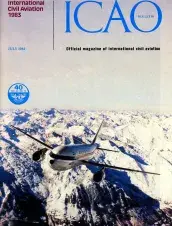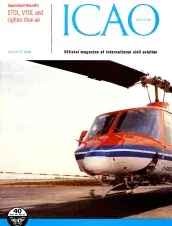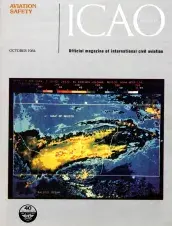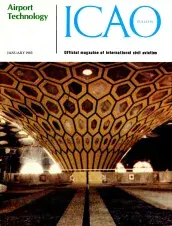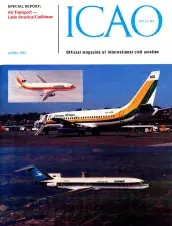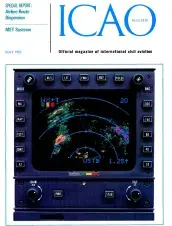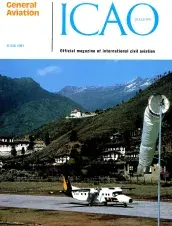Journal OACI
The objective of the Journal is to provide a concise account of the activities of the International Civil Aviation Organization and to feature additional information of interest to Contracting States and the international aeronautical world.
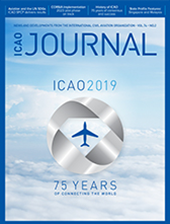 (ICAO Journal is available in English only from 2013)
(ICAO Journal is available in English only from 2013)
This Bell Helicopter 214ST, operated by Okanagan Helicopters Ltd. of British Columbia, Canada, carries a Collins PAC-200 automatic probe antenna/coupler. Connected to an HF transceiver it has been used continuously since late 1982 on flights out of Halifax, Nova Scotia, to off-shore oil exploration platforms as far out as 350 kilometres in the Atlantic Ocean. The self-contained unit avoids problems associated with the long- wire antenna installations previously used.
Cloud top temperature photograph of the volcanic plume rising from El Chichon (Mexico) one day after its eruption of 28 March 1982. A very high resolution radiometer on the NOAA-7 satellite measures radiation from Earth and its atmosphere in the infrared (IR) range. Cloud height is determined by comparing IR data with temperature profiles obtained by radiosonde. Colour progression in the photograph from green to yellow to red indicates a decrease in temperature. The centre of the cloud is colder than the edges owing to its higher altitude.
From the early days of air travel, the postage stamp has helped to record important events in aviation history. Commemorative stamps in honour of ICAO have helped widen interest in aeronautical philately as more and more postal administrations around the world are issuing stamps highlighting civil aviation, its achievements and facilities.
Five Sub-regions comprise the African Region covered in this air transport study: Northern, Western, Central, Eastern and Southern. Its civil aviation involves 125 international airports and 70 international air carriers. Shown are two scheduled operators — EgyptAir (an A300) and Air Madagascar (a B-747).
Shown is the interior of a satellite area at the Abu Dhabi air terminal building. According to architect Paul Andreu of Aéroport de Paris, which directed the entire Nadia Project, the design is intended to reflect the beauty of the desert in which the airport is located — simple, uniformly coloured, blending into the sky, expressing quietude and intensity.
Pratt & Whitney's newly announced PW4000 engine series will be similar in external appearances to this JT9D-7R4. Inside, however, the two engines are radically different. The PW4000 will have 54 per cent fewer parts than the JT9D. In addition, the PW4000 is expected to provide fuel-consumption improvements that are seven per cent better than the JT9D-7R4. Savings to airlines could be about US$1 million a year in fuel costs alone for every four engines, according to company estimates.
Airlines of this Region are numerous and diverse, as will be noted in the report herein. Especially in the South American Sub-Region, Boeing 727s and 737s are prolific. Guiyana Airways launched jetliner service in October 1980 with a B-737, obtained on a long-term wet lease from Maersk Air of Denmark; TAME, the main domestic carrier of Ecuador, operates this B-727 from Quito, at 9,300 feet in altitude, to the port city of Guayaquil daily; Ladeco, operating four B-737s, is based in Santiago, Chile, and is the largest passenger carrier in that State.
Collins' now provides a turbulence-detecting option in its WXR-700 Doppler Weather Radar. Shown is the cockpit display which presents more than just an indication of different rainfall rates. Using a proprietary Doppler-processing technique, changes in the velocity of weather-produced particles relative to other particles can be measured. Thus, turbulence is shown here in magenta within an area of light rainfall -- where a pilot might not otherwise expect it. U.S. FAA approval was given to the system in late February.
This Dornier 228-200 is the first of two aeroplanes comprising the fleet of Druk-air, the new national air carrier of Bhutan (see story beginning on page 11). Operation began last February on a three-times-a-week basis between Bhutan's capital city, Thimbu, and Calcutta in India. So successful has the 90-minute flight been that frequency has been raised to a daily operation since mid-March.
